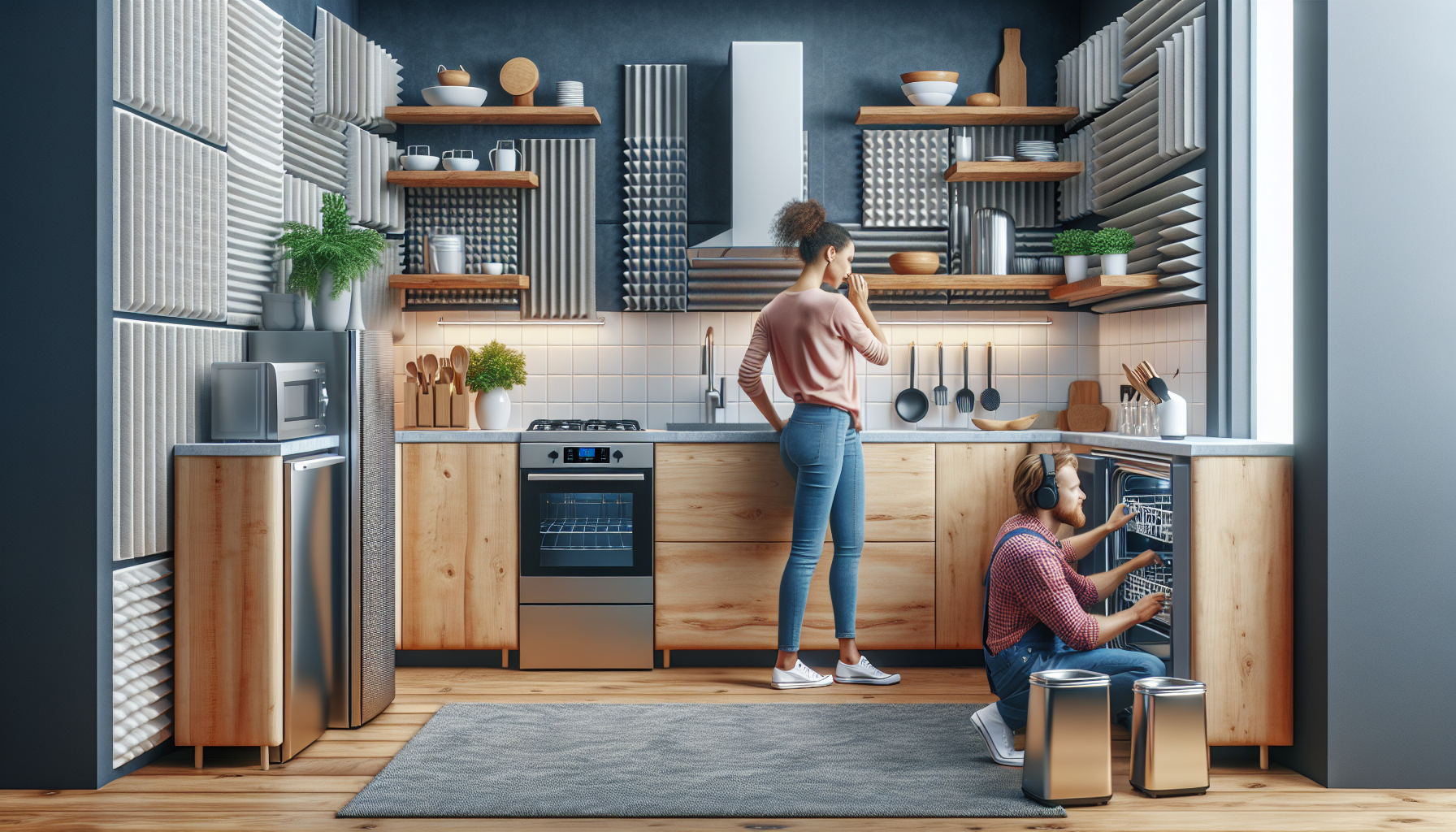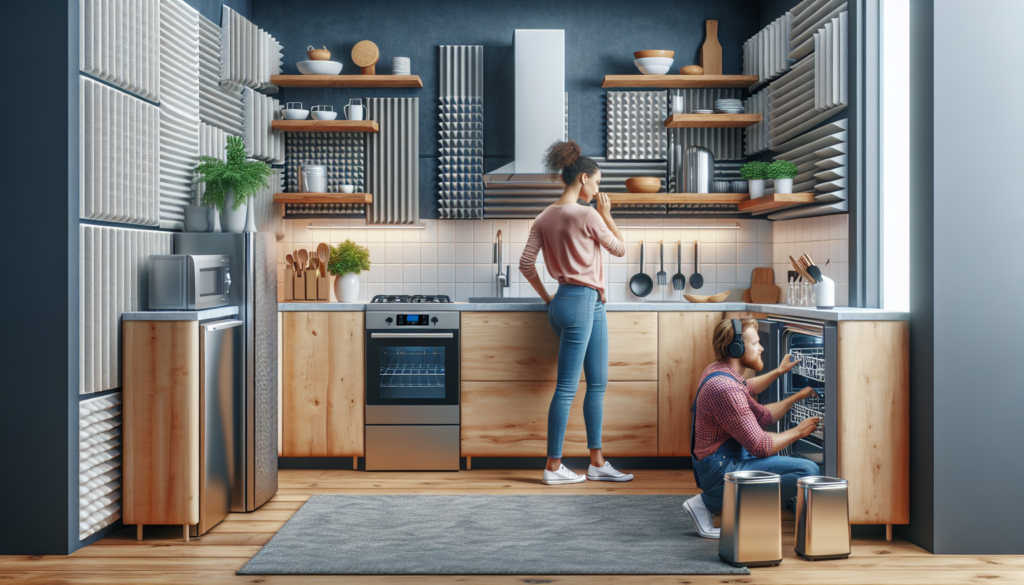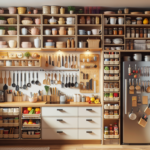
If you find yourself constantly surrounded by the loud buzzing and clanging of your kitchen appliances, fear not! There are simple and effective ways to reduce the noise and create a more peaceful cooking environment. From simple adjustments to soundproofing techniques, this article will provide you with the solutions you’ve been searching for. Say goodbye to the clatter and hello to a quieter, more enjoyable cooking experience.
1. Soundproofing Methods
When it comes to reducing kitchen noise from appliances, there are several effective soundproofing methods you can employ. By addressing gaps and seals, insulating cabinets, using soundproofing mats, installing acoustic panels, and utilizing noise-reducing curtains, you can significantly minimize the noise produced by your appliances.
1.1 Plug Gaps and Seals
One of the easiest and most cost-effective ways to reduce kitchen noise is by plugging gaps and sealing openings around your appliances. These gaps can act as sound pathways, allowing noise to escape and reverberate throughout the room. By using weatherstripping or silicone sealant to seal these gaps, you can contain the noise within the appliance and prevent it from spreading throughout the kitchen.
1.2 Insulate Cabinets
Another effective soundproofing method is to insulate your cabinets. By adding insulation material to the inside of your cabinets, you create a barrier that absorbs sound waves and prevents them from escaping. This not only reduces the noise generated by your appliances but also creates a quieter and more peaceful kitchen environment.
1.3 Use Soundproofing Mats
Soundproofing mats are a popular choice for reducing appliance noise. These mats are specifically designed to absorb sound vibrations and can be placed underneath appliances to minimize noise transmission. Whether it’s a noisy dishwasher or a rumbling refrigerator, soundproofing mats can help dampen the sound and create a more pleasant kitchen environment.
1.4 Install Acoustic Panels
To further enhance the soundproofing of your kitchen, consider installing acoustic panels. These panels are made of sound-absorbing materials, such as foam or fiberglass, and can be mounted on walls or ceilings. By strategically placing acoustic panels near noisy appliances, you can effectively reduce the amount of noise that escapes into the room.
1.5 Use Noise-Reducing Curtains
Noise-reducing curtains are an excellent addition to your kitchen if you’re looking to minimize appliance noise. These curtains are made with special sound-absorbing materials and can be hung near windows or doors to block external noise from entering the kitchen. Additionally, noise-reducing curtains can help absorb sound waves generated by appliances, creating a quieter and more peaceful environment.
2. Proper Appliance Placement
Properly placing your appliances is crucial in reducing kitchen noise. By considering factors such as optimal location, anti-vibration pads, avoiding corners, soundproof surfaces, and creating space between appliances, you can effectively minimize the noise produced by your kitchen appliances.
2.1 Choose the Optimal Location
When it comes to reducing appliance noise, choosing the optimal location for your appliances is essential. Consider placing appliances away from high-traffic areas or rooms where you spend the most time. This ensures that the noise generated by the appliances is less disruptive and doesn’t interfere with your daily activities.
2.2 Use Anti-Vibration Pads
Appliances such as washing machines, dryers, and refrigerators can produce significant vibrations when in operation, resulting in additional noise. To combat this, consider using anti-vibration pads. These pads absorb and dampen the vibrations, significantly reducing the noise produced by the appliances. Simply place the pads underneath the appliances to enjoy a quieter kitchen.
2.3 Avoid Placing Appliances Near Corners
Placing appliances near corners can amplify the noise they produce. This is because sound waves tend to bounce off corners, causing the noise to reverberate and become louder. To minimize this effect, avoid placing your appliances close to corners. Instead, position them in open spaces or against walls away from corners to reduce the reflections and noise buildup.
2.4 Place Appliances on Soundproof Surfaces
Another effective method for reducing appliance noise is to place them on soundproof surfaces. This can include using rubber mats, cork pads, or even specialized soundproofing materials designed for this purpose. By isolating the appliances from direct contact with hard surfaces, you can prevent sound vibrations from transmitting and reduce the overall noise produced.
2.5 Create Space Between Appliances
When arranging your appliances in the kitchen, it’s important to create space between them. This allows for proper airflow and helps dissipate heat, reducing the strain on the appliances and potentially minimizing noise. Additionally, adequate spacing prevents appliances from vibrating against each other, reducing the noise they produce when in operation.

3. Maintenance and Upkeep
Regular maintenance and upkeep of your appliances play a crucial role in reducing kitchen noise. By cleaning and lubricating, replacing worn or faulty parts, tightening loose screws and bolts, checking for leveling issues, and arranging professional servicing, you can ensure that your appliances operate smoothly and quietly.
3.1 Regularly Clean and Lubricate
Regular cleaning and lubrication of your appliances can go a long way in reducing noise. Over time, appliances can accumulate dirt, debris, and even rust, which can contribute to increased noise levels. By establishing a cleaning and lubrication routine, you can keep your appliances in optimal condition and minimize any unnecessary noise.
3.2 Replace Worn or Faulty Parts
Worn or faulty parts in your appliances can often be a significant source of noise. Components such as fan blades, motors, belts, and bearings can wear out over time and cause excessive noise when in operation. If you notice any unusual sounds coming from your appliances, consider inspecting and replacing any worn or faulty parts to restore quiet operation.
3.3 Tighten Loose Screws and Bolts
Loose screws and bolts can contribute to appliance noise by allowing vibrations to amplify and resonate. Regularly check your appliances for any loose screws or bolts and tighten them as needed. This simple maintenance step can help prevent unnecessary noise and ensure that your appliances operate quietly.
3.4 Check for Leveling Issues
Uneven or improper leveling of appliances can lead to excessive noise. If your appliances are not properly balanced, they can vibrate and produce louder sounds when in use. Check the leveling of each appliance and adjust the feet or legs as necessary to achieve proper balance. This can significantly reduce the noise produced by your appliances.
3.5 Arrange Professional Servicing
To ensure the long-term quiet operation of your appliances, it’s important to arrange professional servicing. Regular maintenance by qualified technicians can help identify and address any underlying issues before they become major sources of noise. Additionally, professionals can provide valuable insights and recommendations for minimizing appliance noise in your kitchen.
4. Use Quieter Appliances
If you’re in the market for new appliances or looking to upgrade your existing ones, there are several features and factors to consider that can contribute to a quieter kitchen environment. Look for decibel ratings, choose appliances with insulated motors, opt for variable speed settings, consider energy-efficient models, and invest in appliances with noise reduction features.
4.1 Look for Decibel Ratings
When shopping for new appliances, pay attention to the decibel ratings. The decibel rating indicates the noise level the appliance produces during operation. Lower decibel ratings translate to quieter appliances. Look for appliances with lower decibel ratings to ensure a quieter kitchen environment without sacrificing functionality.
4.2 Choose Appliances with Insulated Motors
Appliances with insulated motors are designed to reduce noise and vibrations. Look for features such as motor insulation or vibration-dampening mounts when selecting appliances. These features help minimize operational noise and provide a more peaceful kitchen experience.
4.3 Opt for Variable Speed Settings
Appliances with variable speed settings allow you to adjust the speed and power based on your specific needs. By choosing appliances with this feature, you can reduce noise levels by running them at slower speeds when maximum power is not required. This flexibility enables you to have control over the noise output of your appliances.
4.4 Consider Energy-Efficient Models
Energy-efficient appliances not only help you save on energy bills but can also contribute to a quieter kitchen. These appliances are designed to operate more efficiently, resulting in reduced noise levels. Look for appliances with the Energy Star label, as they meet strict criteria for energy efficiency.
4.5 Invest in Appliances with Noise Reduction Features
Some appliances come with built-in noise reduction features. These can include specialized insulation, advanced sound-absorbing materials, or innovative design elements that minimize noise. Investing in appliances with these features can significantly reduce kitchen noise and create a more peaceful cooking and dining environment.

5. Dishwasher Noise Reduction
The dishwasher is a commonly used appliance in the kitchen and can contribute to significant noise levels. By following these tips, such as loading dishes properly, using soundproof dishwasher insulation, choosing a quieter dishwasher model, avoiding simultaneous appliance use, and scheduling dishwasher usage strategically, you can enjoy a quieter kitchen experience.
5.1 Load Dishes Properly
Properly loading your dishes into the dishwasher can make a big difference in noise levels. Ensure that dishes are stacked securely and don’t clatter against each other during the wash cycle. This reduces unnecessary noise and promotes smooth and quiet operation of the dishwasher.
5.2 Use Soundproof Dishwasher Insulation
Some dishwashers come equipped with soundproof insulation designed to reduce noise. If your dishwasher does not have built-in insulation, you can consider adding soundproofing materials specifically designed for dishwashers. These materials help absorb sound vibrations and minimize noise transmission, resulting in a quieter dishwasher.
5.3 Choose a Quieter Dishwasher Model
When it’s time to replace your dishwasher, consider choosing a model specifically known for its quiet operation. Look for dishwashers with low decibel ratings or those that feature specialized noise reduction technologies. These can include features such as noise insulation, sound-absorbing materials, or quiet motor systems. Investing in a quieter dishwasher can significantly reduce appliance noise in your kitchen.
5.4 Avoid Running Appliances Simultaneously
Running multiple appliances concurrently can lead to increased noise levels in the kitchen. Avoid running the dishwasher, blender, coffee maker, or any other noisy appliances simultaneously. By staggering their usage and avoiding overlapping operation, you can minimize the overall noise in your kitchen and ensure a more peaceful environment.
5.5 Schedule Dishwasher Usage Strategically
Strategically scheduling dishwasher usage can further reduce noise in your kitchen. Consider running the dishwasher during periods when you and your family are less likely to be in the kitchen, such as during off-peak hours or before bedtime. This way, you can enjoy a quiet and tranquil kitchen atmosphere during your waking hours.
6. Refrigerator Noise Reduction
Refrigerators are essential appliances in the kitchen, but their continuous operation can lead to noise concerns. By implementing these noise reduction techniques, such as cleaning condenser coils regularly, checking and adjusting the defrost cycle, isolating the refrigerator’s vibration, utilizing noise-reducing mats, and opting for a quieter refrigerator model, you can minimize refrigerator noise and create a more serene kitchen environment.
6.1 Clean Condenser Coils Regularly
Clean condenser coils are crucial for maintaining the optimal performance of your refrigerator and reducing noise levels. Over time, dust and debris can accumulate on the condenser coils, making the refrigerator work harder and produce more noise. Regularly cleaning the condenser coils, typically located on the back or underneath the refrigerator, helps prevent excessive noise and ensures efficient operation.
6.2 Check and Adjust the Defrost Cycle
Some refrigerators have a defrost cycle that can contribute to noise, particularly if it’s improperly adjusted. Check your refrigerator’s defrost cycle settings and make sure they are set correctly. Adjusting the defrost cycle can help optimize its operation, potentially reducing noise levels and ensuring quieter refrigeration.
6.3 Isolate the Refrigerator’s Vibration
The vibration produced by a refrigerator can contribute to noise levels in the kitchen. To minimize this vibration, consider isolating the refrigerator by placing rubber or cork pads underneath it. These pads absorb vibrations and help prevent them from transferring to the surrounding environment, resulting in reduced noise levels and a more peaceful kitchen.
6.4 Utilize Noise-Reducing Mats
Another effective method for reducing refrigerator noise is to use noise-reducing mats. These mats are specifically designed to absorb sound vibrations and can be placed underneath or behind the refrigerator to minimize noise transmission. Noise-reducing mats can significantly reduce the operational noise of your refrigerator, creating a quieter kitchen environment.
6.5 Opt for a Quieter Refrigerator
If your current refrigerator is excessively noisy, it may be worth considering upgrading to a quieter model. When shopping for a new refrigerator, look for models with noise reduction features or lower decibel ratings. Pay attention to reviews and product specifications to ensure that you select a refrigerator that operates quietly and fits your noise reduction needs.
7. Oven and Range Hood Noise Reduction
Ovens and range hoods are essential components of a functional kitchen but can sometimes be noisy during operation. By implementing these noise reduction techniques, such as insulating surrounding cabinets, using soundproof mats for the oven, installing a quieter oven range hood, positioning burner pans correctly, and cleaning or replacing exhaust fan filters, you can maintain a quieter and more enjoyable cooking experience.
7.1 Insulate Surrounding Cabinets
One effective way to reduce oven and range hood noise is to insulate the surrounding cabinets. The heat and noise generated by these appliances can cause vibrations and amplify noise levels. By adding insulation material, such as foam or fiberglass, to the inside of the cabinets, you can minimize vibrations and reduce the noise transmitted from the oven and range hood.
7.2 Use Soundproof Mats for Oven
Placing soundproof mats underneath the oven can help absorb vibrations and prevent them from transferring to the surrounding area. These mats come in various sizes and thicknesses and are designed to minimize noise transmission. By using soundproof mats, you can significantly reduce the operational noise of your oven and enjoy a quieter cooking experience.
7.3 Install a Quieter Oven Range Hood
Range hoods play a crucial role in ventilating your kitchen and removing cooking odors, but they can also produce noise. If your oven range hood is excessively loud, consider upgrading to a quieter model. Look for range hoods with lower decibel ratings or those with noise reduction features. By installing a quieter range hood, you can minimize noise levels in your kitchen while still enjoying the benefits of proper ventilation.
7.4 Position Burner Pans Correctly
Improperly positioned burner pans on stovetops can generate unnecessary noise. When using the oven, ensure that the burner pans are placed correctly on the cooktop and are not loose or unbalanced. Well-positioned burner pans can help minimize vibrations and reduce noise levels during cooking.
7.5 Clean or Replace Exhaust Fan Filters
Exhaust fan filters in the oven range hood can accumulate grease and debris over time, leading to reduced airflow and increased noise. Regularly clean or replace the exhaust fan filters to ensure optimal ventilation and reduce noise levels. This simple maintenance step can keep the fan running smoothly and quietly, contributing to a more peaceful cooking environment.
8. Washer and Dryer Noise Reduction
Washers and dryers are commonly found in the kitchen or nearby laundry areas, and their noise can be disruptive. By implementing these noise reduction techniques, such as maintaining proper washer leveling, using anti-vibration pads for laundry machines, insulating the laundry room, cleaning the dryer vent regularly, and opting for energy-efficient washer and dryer models, you can enjoy a quieter laundry experience.
8.1 Maintain Proper Washer Leveling
Proper leveling of your washing machine is crucial in reducing noise and vibrations. A washer that is not evenly balanced can vibrate excessively and produce loud noise during operation. Use a bubble level or consult the manufacturer’s instructions to ensure that your washer is level. By maintaining proper leveling, you can minimize vibrations and enjoy a quieter laundry experience.
8.2 Use Anti-Vibration Pads for Laundry Machines
Laundry machines, particularly spin cycles, can generate significant vibrations and noise. To mitigate this, consider using anti-vibration pads specifically designed for washers and dryers. These pads dampen vibrations and absorb sound, resulting in reduced noise transmitted to the floor and surrounding areas.
8.3 Insulate the Laundry Room
Insulating the walls and floors of your laundry room can help absorb sound and minimize noise transmission. Consider adding sound-absorbing materials such as foam or fiberglass insulation to the walls or installing soundproofing panels. Additionally, using area rugs or carpeting can help reduce noise reflections and create a quieter laundry environment.
8.4 Clean the Dryer Vent Regularly
A clogged or improperly maintained dryer vent can lead to increased noise levels. Regularly cleaning the dryer vent helps ensure proper airflow and efficient drying performance. Additionally, a clean vent reduces strain on the dryer, potentially minimizing noise during operation. Remember to follow the manufacturer’s guidelines for vent cleaning and maintenance.
8.5 Opt for Energy-Efficient Washer and Dryer
When the time comes to replace your washer and dryer, consider opting for energy-efficient models. Not only do these appliances help you save on energy costs, but they often operate quieter than older, less efficient models. Energy-efficient washers and dryers are designed with advanced features and technology that minimize noise levels, ensuring a more peaceful laundry experience.
9. Blender and Food Processor Noise Reduction
Blenders and food processors are versatile kitchen appliances, but their noise can be bothersome. By employing these noise reduction strategies, such as choosing heavy-duty blenders, utilizing soundproof enclosures, blending or processing in short bursts, opting for appliances with noise shields, and selecting low-noise models, you can enjoy quieter blending and food processing sessions.
9.1 Choose Heavy-Duty Blenders
Heavy-duty blenders typically have more powerful motors and are designed to handle tougher tasks. These blenders often operate more smoothly and quietly compared to their lower-powered counterparts. Invest in a heavy-duty blender to minimize noise during blending and enjoy a quieter kitchen experience.
9.2 Utilize Soundproof Enclosures
For those who frequently use blenders or food processors and want to reduce noise, soundproof enclosures are an effective solution. These enclosures are specifically designed to fit over the appliance and contain noise. Made of sound-absorbing materials, they significantly dampen the noise produced during operation, allowing you to blend or process ingredients without disturbing others.
9.3 Blend or Process in Short Bursts
To further minimize noise during blending or food processing, consider blending or processing ingredients in short bursts. Instead of running the blender or food processor continuously, pulse or blend in short intervals, allowing the appliance’s noise to be reduced during pauses. This technique helps reduce overall noise levels and can be particularly useful in a shared living space.
9.4 Opt for Appliances with Noise Shields
Some blenders and food processors come equipped with noise shields or enclosures as part of their design. These shields are incorporated to reduce noise levels during operation. When selecting a blender or food processor, look for models that offer noise shields or enclosures to enjoy a quieter blending and food processing experience.
9.5 Select Low-Noise Models
When choosing a blender or food processor, consider models specifically designed to operate quietly. These models are engineered with noise reduction features such as specialized motor systems, insulation, or vibration-dampening materials. Look for blenders and food processors with low decibel ratings or those marketed as having quiet operation to minimize noise in your kitchen.
10. Coffee Maker and Microwave Noise Reduction
Coffee makers and microwaves are often used appliances in the kitchen, and their noise can be disruptive. By implementing these noise reduction techniques, such as selecting quieter coffee makers, insulating the surrounding area, avoiding placing the microwave near walls, opting for a microwave with sound dampening, and scheduling coffee maker and microwave usage strategically, you can enjoy a quieter coffee and reheating experience.
10.1 Select Quieter Coffee Makers
To minimize noise from your coffee maker, consider choosing models specifically designed for quiet operation. Look for coffee makers with insulated carafes or noise reduction features. Additionally, coffee makers with advanced brewing systems often operate more quietly. By selecting a quieter coffee maker, you can enjoy your morning brew without the excess noise.
10.2 Insulate the Surrounding Area
Insulating the area around your coffee maker or microwave can help minimize noise transmission. Consider placing sound-absorbing materials such as foam or cork pads underneath or behind the appliances. Additionally, positioning the appliances away from hard surfaces can help prevent sound vibrations from bouncing and amplifying noise levels in the kitchen.
10.3 Avoid Placing Microwave Near Walls
When positioning your microwave, avoid placing it directly against a wall. Microwaves often generate vibrations and noise during operation, and placing them against a wall can cause the noise to reverberate. Instead, ensure there is a small gap between the microwave and the wall to minimize acoustic reflections and reduce overall noise levels.
10.4 Opt for Microwave with Sound Dampening
If you’re in the market for a new microwave, consider choosing models with sound dampening features. These microwaves are designed to minimize noise levels during operation. Look for advanced noise reduction technologies, such as insulated casings or quiet motor systems, to enjoy a quieter reheating experience in your kitchen.
10.5 Schedule Coffee Maker and Microwave Usage
Strategically scheduling the usage of your coffee maker and microwave can help minimize overall noise levels in the kitchen. For example, if you’re an early riser, consider setting your coffee maker to start brewing before you wake up. This way, you can enjoy your morning coffee without the noise of the brewing process disrupting others. Similarly, choose opportune times to use the microwave, such as during periods when the kitchen is less occupied, to reduce noise disturbances.
By incorporating these soundproofing methods, proper appliance placement techniques, maintenance and upkeep practices, quieter appliance options, and specific noise reduction tactics for different kitchen appliances, you can significantly reduce kitchen noise from appliances. Enjoy a quieter and more enjoyable cooking and dining experience while maintaining a serene kitchen environment.






